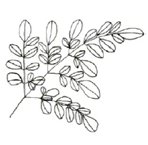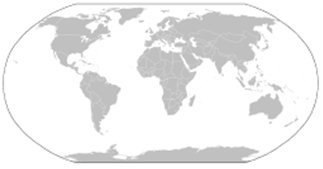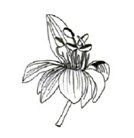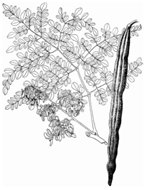| The moringa fruit
or pod is about 30 to 50 centimeters long and the seeds contain
oil. |
|
How do we grow Moringa?
Rainfall and elevation of land
Moringa requires rainfall of not less than 250 and 3000 mm annually.
The Moringa plant is drought tolerant. During the summer the leaves
may be lost. This does not mean that plant is dead, because new
leaves will sprout when the rainy season comes.
Moringa can be grown in mountainous areas 1000 meters
above sea level.
Temperature requirements
Moringa can withstand temperatures ranging from 25C
to 40C.
Soil
Moringa tolerates sandy clay soil.
Use of Moringa
30% of children in sub-Saharan Africa are protein deficient.
Moringa is an extremely valuable food source. All parts of the Moringa
tree can be uses. Moringa has many minerals and vitamins for human
and veterinary use.
Moringa also cleans dirty water and is used as medicine.
In agroforestry, biomass can provide compost.
Other uses:
• Human Food
• Animal feed
• Traditional Medicine
• Fertilizer
• Enclosure
• Agroforestry
• Spray insecticides
Human Food
Moringa has many advanced used. The leaves can be eaten or cooked.
Young seeded pods, flowers, roots and bark of the tree, are used
as food. The leaves do not contain oil, but are rich in minerals
and vitamin B. This is an ideal food in times of famine when there
is no food.
Gram-for-gram comparison of nutritional
data
- Moringa has 7 x more Vitamin C than oranges
- 4 x more Vitamin A than in carrots
- 4 x more Calcium than in milk
- 3 x more Potassium than in bananas
- 2 x more Protein than in yogurt
Leaves
The leaves are used more than any other part of the Moringa. It
is advisable to pick the leaves when they are young. The leaves
are removed from the stalks. The leaves can be steamed or cooked
like spinach, providing a leafy green protein source.
The easiest way to cook it is to boil two cups of
leaves for a few minutes in water with onion, butter, salt and other
ingredients such as corn and other vegetables.
• Water produced by squeezing the leaves reduces
the leakage of blood in the wound.
• Leaves made into a tea can reduce fever in Malaria.
• Leaf tea reduces pain in the wound and relieves diarrhoea.
• The water also heals inflammation and skin rash.
• Water from the leaves heals stomach ulcers and diarrhea.
Flowers
• Crush the flowers in hot water to facilitate breastfeeding
by increasing milk flow.
• Similarly, this water helps with urinary problems by increasing
urinary output.
Dried Leaves
Dried leaves can be made into flour that can be added to sauces.
| 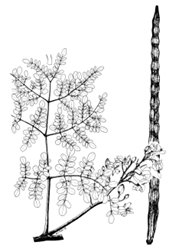
|
Flowers
The flowers can be eaten or mixed with other foods.
It also can be placed in hot water for five minutes to make
medicine.
Flowers also attract bees.
Pods
Pods can be used young when they are 30 cm long. They are
cooked like beans and it smells like asparagus. It is advisable
to introduce
|
• Green pods can be used to reduce worms and also heals diseases
of the liver, spleen and joints.
• Because of the abundance of protein and fiber the husk is
used to treat severe malnutrition and diarrhea.
Over three years one Moringa tree can produce seed pods in excess
of 300 each year. A mature tree can provide 1000 seeds. To prevent
the tree from growing too tall harvest regularly, this helps produce
more branches and facilitate the harvest.
| Seeds
The seeds are similar to lentil-peas. Seeds
may be used when green. With a little practice you will soon
know the best time to harvest the seeds.
You will need to rinse the seeds to remove
the shells and bitter covering.
|
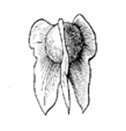 |
You can then pour a little boiling water over the
seeds.
Seeds from mature pods are hard. Mature seeds can
be grated and pressed for oil. If there is no device, seeds can
be roasted then crushed and dissolved in hot water. Seed oil can
be used for frying.
The seeds contain 35 percent oil and can be used
for cooking or burning in lamps as it does not smoke.
Medicinal use of Seeds
• Used to treat disorders of the joints
• Seed oil helps increase urineary output.
• The seeds are used to treat or prevent epilepsy.
Root
Plants reach a height of 60 cm, the root can be chopped and used
as horseradish. Remove the bark of the root as it contains toxins.
Crush the roots and add salt and vinegar. This can be produced in
bulk and keeps well.
Tests
Tests were performed in Senegal to examine the ability of Moringa
leaf powder to prevent or cure malnutrition in pregnant or breast-feeding
women and their children.
Results:
• Children maintained or increased weight and improved health.
• Pregnant women recovered from anemia and had babies with
higher birth weights.
Food of Animal
Cattle, rabbits, sheep, pigs, goats and chickens consume the pods,
leaves and young plants as food.
|
Appropriate nutrition for pigs:
• 70 percent Moringa
• 10 percent of Leucaena
• 20 percent of other branches eg Mulberry
You can multiply percentage up to 100 percent for Moringa
but not that of Leucaena. |
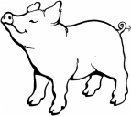
|
If the plant is intended to feed livestock cut it
down to four meters.
Moringa can reach six meters and can be cut back to facilitate harvesting.
| 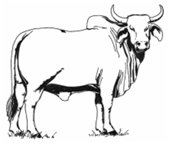
|
Moringa fodder for cows:
50% Moringa leaves and 50% molasses, sugar
cane and grass will result in:
• Increases daily weight gain up to 32%
• Increases milk production 43% to 65%
The young branches left over from the processing can be cut
into 10cm strips and given to the cows. |
The cost of animal feed is greatly reduced by introducing
Moringa.
Moringa can be used for fodder for rabbits.
Moringa can be added to the fish tank as excellent fish food.
This along with the organic chicken droppings from the layers pen
can reduce the amount of commercial food needed for the fish by
over 20%.
Cleaning water
Chaff of the seed can be used to make wastewater clean. This chaff
traps the dirt particles and they sink to the bottom killing 90-99
percent of the bacteria.
Moringa is used instead of expensive chemicals which can damage
your health and the environment.
Twenty liters of water can be made as follows:
1. Choose the best Moringa seeds.
2. Grind the seeds to make a soft dough.
3. Add 2 grams (two tablespoons small) of Moringa seed paste to
a small amount of water in a cup or bottle, then shake for five
minutes.
4. Strain the dirty water through a clean cloth.
5. Add the Moringa seed paste. Stir rapidly for two minutes and
then slowly for 10 to 15 minutes (do not use metal stirring spoon).
6. Leave the bucket for an hour until the water is clear and dirt
sinks to the bottom.
7. Filter the water in a clean towel.
8. Boil the water before drinking.
Medical uses
Moringa has been used worldwide to treat a variety of diseases.
Some treatments are discussed here, but are not a guarantee to work.
Fencing
If planted as a fence, Moringa trees block the wind. If the plants
are planted 1 meter apart after just three months they can be used
to restrain animals from passing.
How
to plant Moringa
SOWING SEEDS OF SUCCESS - MORINGA CURRICULUM
|


